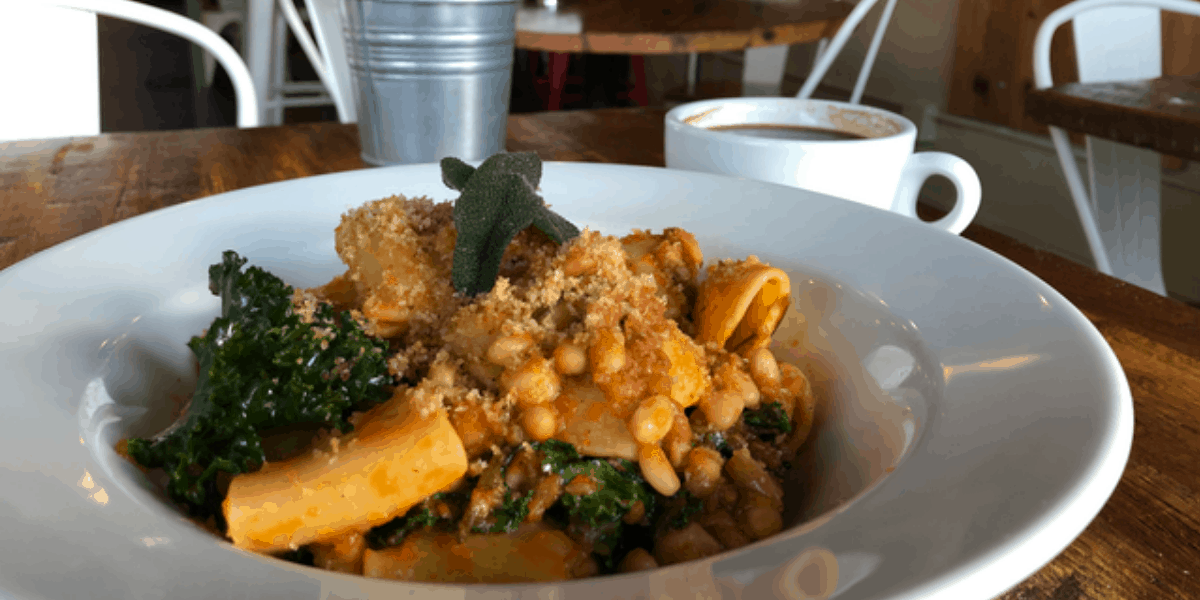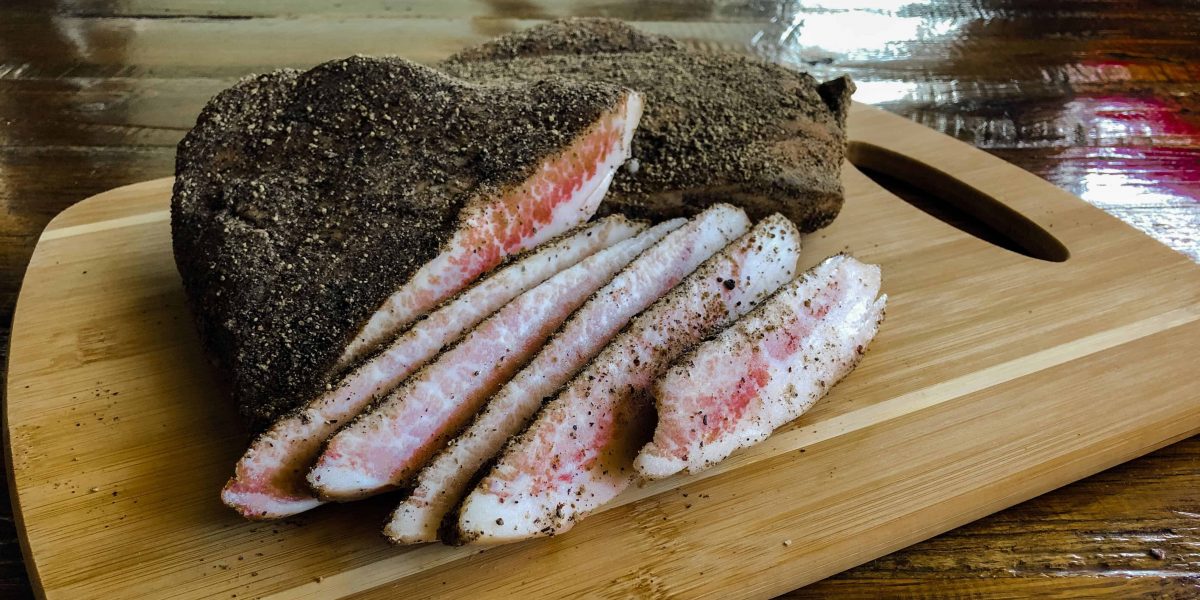New menu item: Pasta alla Gricia
Previously on the Due’ blog, we spoke about our passion for cooking traditional dishes like carbonara and amatriciana the right, traditional way with guanciale. We explained how we make our own in house from an authentic blend of spices and WA sourced pork. We’re adding another menu item which uses this special ingredient for your to enjoy it’s rich flavor: pasta alla gricia.
Origins of Gricia:
This dish is another ancient dish from Roman cuisine, which is commonly considered the mother of all Roman pastas. There are different stories about the origin of the name gricia. The most widely known is that it is derived from the name of the village where the pasta is said to have originated, Grisciano. Another theory is that the word gricia is a bastardized version of grigio which means gray. This might be referring to the gray cast left on an iron skillet from frying guanciale.
Other theories range from the name grici,the inhabitants of the origin area.
Simple, quick, yet powerful in flavor:
One interesting story claims that Grigioni, a medieval name for the German and Swiss bakers who came to Rome and cured pork, is the origin of the word and dish. These bakers were quite hard working and this dish was a simple, fast favorite of their lifestyle. With an origin like this, pasta alla gricia should be a perfect fit for our hardworking American lifestyle as well! All of these old histories may hold a piece of the truth; we may never know.
What really matters is how this dish has captivated generations of Italians and now pasta lovers around the world for literally thousands of years. It’s simple, yet rich in flavor recipe has secured its place as a timeless classic. To make pasta alla gricia, it’s quite simple: pecorino romano cheese, black pepper, salt, and our guanciale. It’s incredibly short ingredient list is packed with powerful flavors that work beautifully in unison.
This simple, powerful dish is perfect for a satisfying lunch in the middle of your busy day; just like the origin stories suggest! Come in and join us this week for a perfectly crafted plate.
New menu item: Vegan bean ragout
New menu item: Vegan Bean Ragout
We’re bringing you another Tuscan classic made our way at Due’. Look out this week as we add Vegan Bean Ragout to our menu.
With our new Vegan Bean Ragout, we've created our own, modern version of the authentic Italian dish Pasta & Fagioli. In the United States, you know this dish as “Pasta Fasul” as well, derived from the traditional name. Though you’re likely familiar with this pasta and bean dish, it has a long standing history in Italy. It’s arguably the “national” dish of Italy in the sense that every region honors and has its own rendition of this favorite. This dish is said to be originally from the Campania part of Italy and, as many Italian classics, began as a ‘Cucina Povera’ or food of the poor. It’s simple ingredients reflect this but it’s rich flavors ensured this dish one served across Italy and the world for generations. It’s one of the best expressions of this Italian culinary heritage.

Our modern take:
For the base of our ragout, we use a rich blend of Heirloom black valentines beans, Navy beans, and Garbanzo beans. At Due’, we’ve modernized the dish with the use of sourdough breadcrumbs and crispy aromatic herbs. We also pay even further homage to Tuscany by adding black cabbage, as a nod to Tuscanian cabbage soup "Ribollita". This adds a hearty, veggie-base that is perfect for a warm winter meal.
 This dish is by nature vegetarian but you can request we make it vegan for you! If none of that appeal to you and you’re a meat eater, we can also add in homemade pork sausage for a rich, hearty meal. Pair this dish with a glass of Chianti and you have the ultimate Tuscanian experience.
This dish is by nature vegetarian but you can request we make it vegan for you! If none of that appeal to you and you’re a meat eater, we can also add in homemade pork sausage for a rich, hearty meal. Pair this dish with a glass of Chianti and you have the ultimate Tuscanian experience.
Come in and try our version of this all-Italian classic this week!
Why we use Guanciale
Just like America has great rivalries like Budweiser vs Miller Light, Italy has our own (a bit more substantial) food rivalry’s and unwritten blasphemies. One of the most infamous is guanciale vs pancetta. So much so that this centuries old tradition has crossed over into meme culture with popular memes bashing either choice.
We’d like to settle this once and for all with our recipes at Due’ Cucina: guanciale is the right answer.
We’ll give you a little background on guanciale:
First of all, you may be wondering, what is guanciale? Most Americans have probably heard of Pancetta, which is essentially pork belly that is salt and pepper cured. Very few have heard of guanciale. Guanciale is the pork jowl (cheek) cured in a mix of salt and spices. The differences are slight but they’re definitely there. Guanciale is a speciality of central Italy (not surprisingly, close to where we're from).

How we make it:
To make guanciale, we rub the pork cheek in a mix of salt and spices and cured for one week. Then we dry cure it for a minimum of 6 weeks. The flavor comes out much stronger than Pancetta and it has a softer texture. When cooked into traditional sauces, the fat melts away revealing strong, deep flavors that completely transform the sauce. It’s a small detail, but an Italian that knows what true traditional flavor is will know the difference and why guanciale is the choice over pancetta.
Some typical sauces and dishes you may see guanciale in Carbonara and Amatriciana sauces. At Due’ we use guanciale in our Amatriciana this way, following the Roman tradition. We even take it a step further. We source the pork locally from Washington organic farms, spice, and cure the meat in house to make sure we get the authentic Roman flavor for our dishes.
We’ve also introduced another very traditional way of using guanciale: in our Cacio&Pepe. Normally this dish is meatless but with the addition of guanciale to create “Gricia” or a variation of Cacio&Pepe with that rich flavor of guanciale. This dish is popular and native to the area around Rome.
Next time you’re in, try one of our dishes featuring guanciale and be certain, you’re eating Italian done the real way!
EXPLORE OUR MENU


 This dish is by nature vegetarian but you can request we make it vegan for you! If none of that appeal to you and you’re a meat eater, we can also add in homemade pork sausage for a rich, hearty meal. Pair this dish with a glass of Chianti and you have the ultimate Tuscanian experience.
This dish is by nature vegetarian but you can request we make it vegan for you! If none of that appeal to you and you’re a meat eater, we can also add in homemade pork sausage for a rich, hearty meal. Pair this dish with a glass of Chianti and you have the ultimate Tuscanian experience.